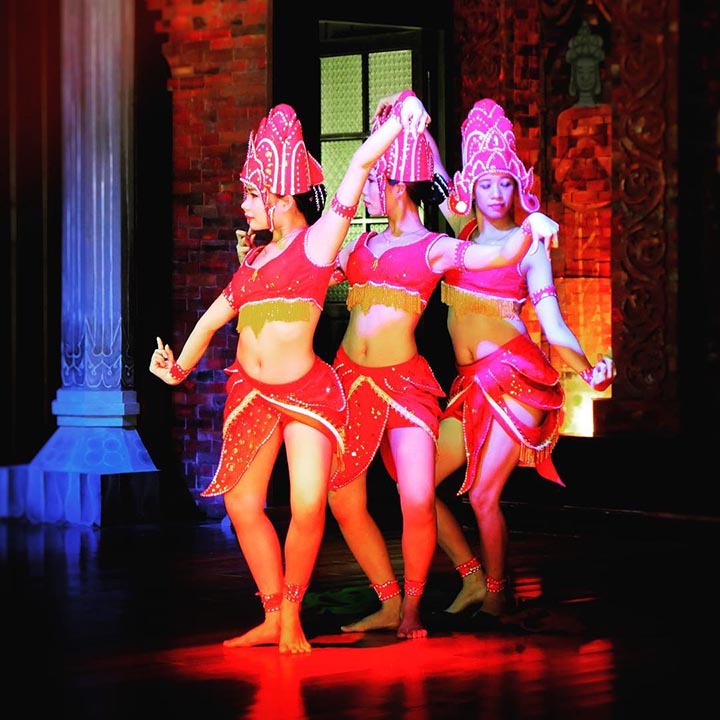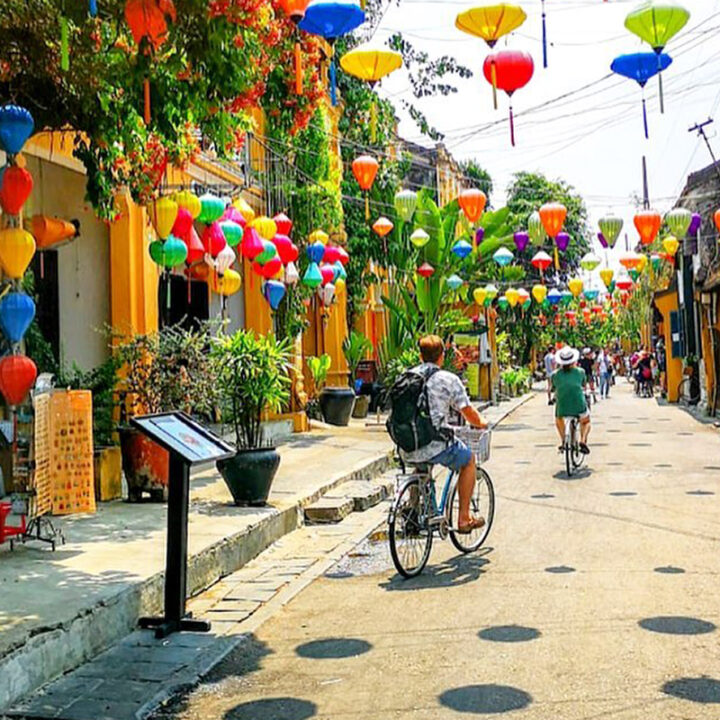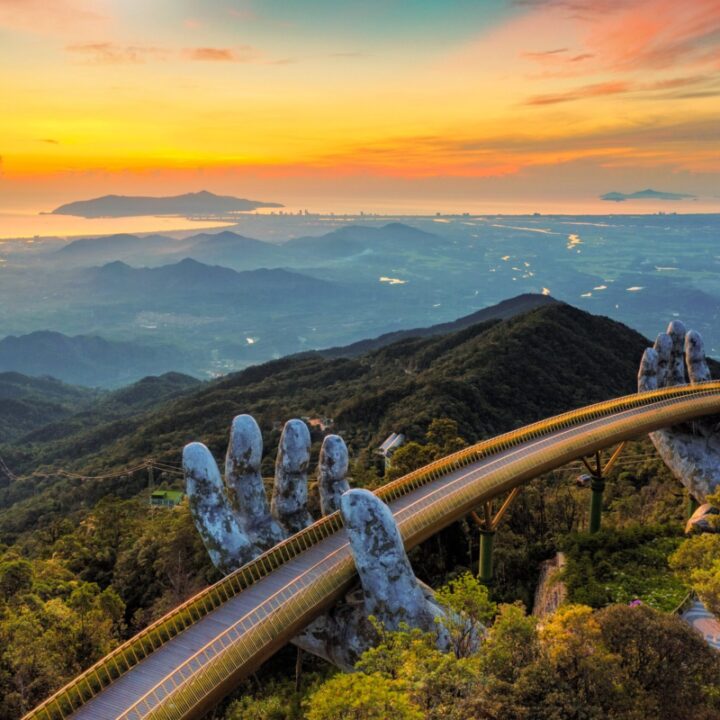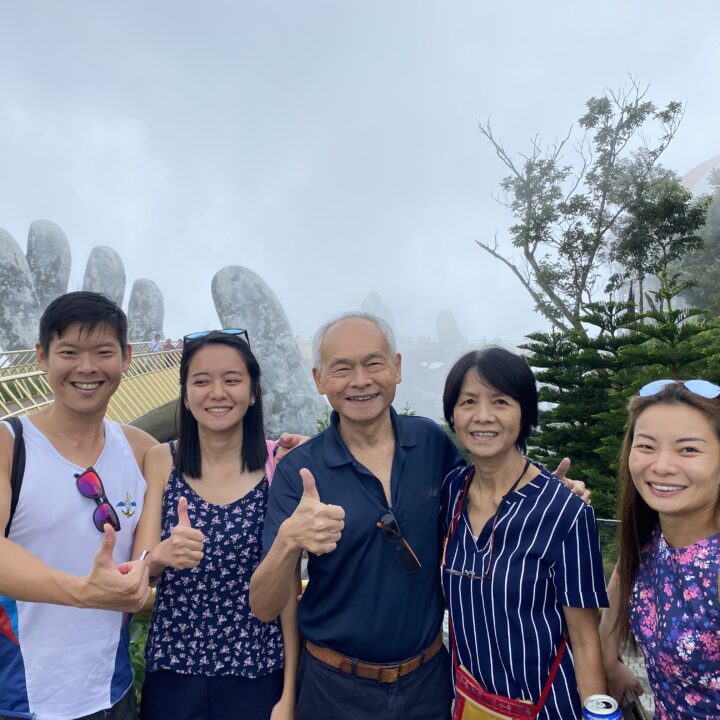Located about 50 km from Da Nang city, in Quang Nam province, My Son Sanctuary appears with an architectural complex of many Champa temples and unique architecture.
Forgotten for centuries, it was not discovered until 1885. In 1999 it was selected by UNESCO as a world cultural heritage as the only evidence of Asian civilization that disappeared. If you would likes to explore and learn about this ancient culture, this is a place worth exploring.
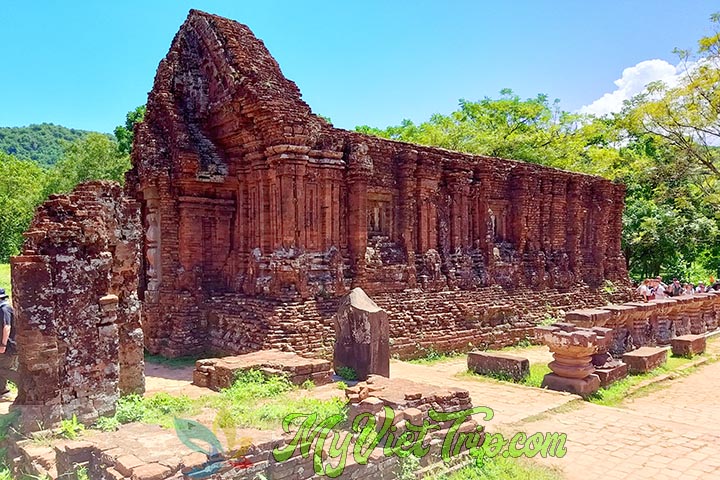
What to do in My Son Sanctuary
My Son Sanctuary is a complex of Champa temples ruins in Duy Phu commune, Duy Xuyen district, Quang Nam province. FromTra Kieu is 20 km to the west, 45 km from Hoi An to the west, from Danang more than 50 km to the southwest, and from Hue Imperial City about 145 km to the south. This area is a valley with a diameter of about 2 km, surrounded by hills and mountains. This is the place to organize sacrifices as well as the tomb area of the kings and princes of the ancient Champa dynasties. In 1999, Vietnam’s My Son Sanctuary was recognized by UNESCO as a World Cultural Heritage site.
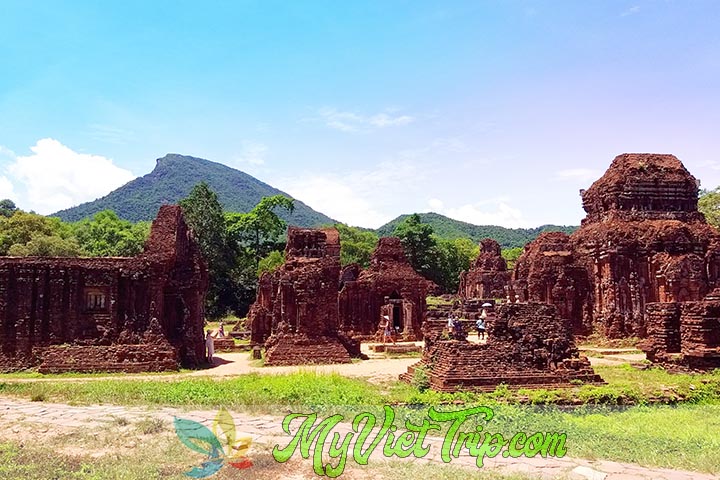
History of My Son Sanctuary
My Son Sanctuary is considered one of the main Hindu temple centers in Southeast Asia and is the only Hinduism heritage site in Vietnam.
My Son Sanctuary is in a closed valley with majestic mountains and magnificent terrain. Here, with more than 70 buildings and structures of Champa civilization exist in the permanent material relics, containing values of history, culture, architecture and art created in one For a long time during 9 centuries (from the 4th century to the 13th century), is considered on par with famous monuments in Southeast Asia such as Angkor, Bagan (Myanmar), Borobudur (Indonesia).
Kazik (Kazimierz Kwiatkowski (1944-1997)) – a talented architect who has been with My Son for many years – exclaimed “the ancient Champa people sent their spirituality to rock; and have known to rely on nature to create a majestic – magnificent My Son holyland. This is a museum of sculptural architecture extremely valuable art of human and it will take us a lifetime to understand.”
Time and war of Vietnam has devastated monuments. But what is left in My Son still plays an extremely important role in the historical and cultural heritage of the world art and architecture.
With the outstanding global values of a cultural heritage site that needs to be protected for the benefit of all humanity, December 4, 1999, in the city of Marr kesk – Republic of Marocco, My Son Sanctuary has its name on UNESCO’s list of world cultural heritage.
My Son Sanctuary was probably started to build in the fourth century. For centuries, this Sanctuary has been supplemented with large and small towers and has become the main relic of Champa culture in Vietnam. In addition to the function of performing ceremonies, helping dynasties reach to gods, My Son was also the cultural and religious center of the Champa dynasties and the burial place for powerful kings and monks.
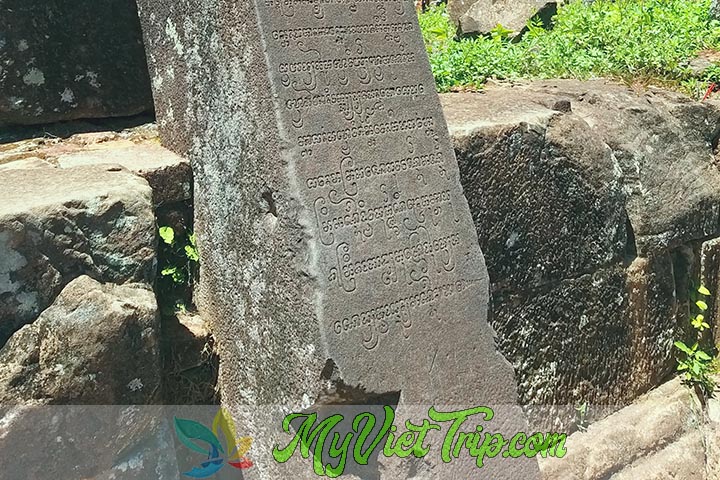
The first relics found mark the time of King Bhadravarman I (Pham Ho Dat) (reigned from 381 to 413), the king built a Kalan to worship linga / yoni and the god Shiva. My Son is heavily influenced by India both in architecture (reflected in the temples steeped in the splendor of the past), and in culture – represented by ancient Sanskrit inscriptions on steles.
Based on other inscriptions, it is known that this site once had the first temple made of wood in the fourth century. More than 2 centuries later, the temple was destroyed in fire. In the early seventh century, King Sambhuvarman (Pham Phan Chi) (reigned from 577 to 629) used clay bricks to rebuild the temple that still exists today.
The later kings continued to remodel the old temples and build new temples to worship the gods. Brick is a good material to retain the memories of a mysterious empire. The technique of building these towers of the Champa people is still a mystery. It has not yet found a convincing answer about the material of binding, brick burning method and construction.
The towers and tombs date from the seventh to the fourteenth centuries, but the excavation results show that the Cham kings were buried here in the fourth century. The total number of buildings is 72 units. My Son Sanctuary may be the center of religion and culture of the Champa state when the capital of this country is Tra Kieu (Simhapura Capital) or Dong Duong.
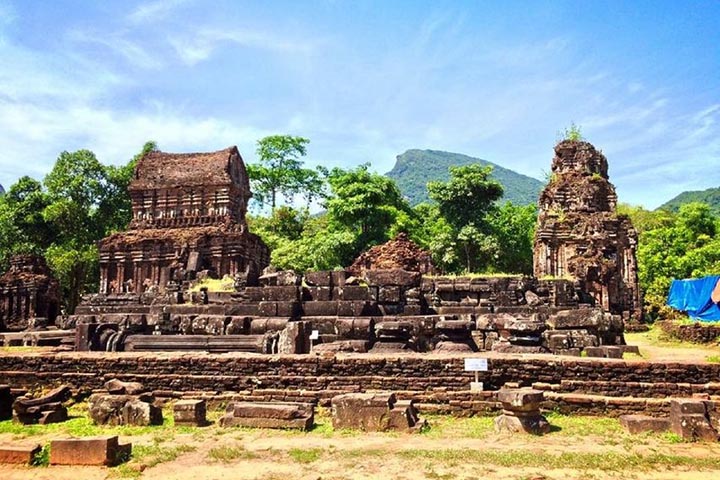
Champa temples in My Son Holyland
Art and architecture through the layout of the temple are greatly influenced by Indian style. The Holy Zone consists of many towers, each of which has a main tower (Kalan) in the middle and many small auxiliary towers surrounding it. Kalan often worshiped the statue of Linga or the statue of Shiva. In front of each cluster is a Gate Tower (Gopura), followed by the vestibule (Mandapa), this work item has the function of arranging offerings and singing and performing rituals.
Next to it is an architecture that always turns to the North (the direction of the god of wealth – Kuvera), consisting of 1 or 2 rooms, called Kósa Grha used to store sacrifices and food for the gods. The towers are pyramidal, symbolizing the holy Meru peak, the residence of Hindu gods. The gate of the tower usually turns to the east to receive sunlight. Many towers have very beautiful architecture with images of gods decorated with many types of patterns.
Most of these structures have been damaged and degraded by the time, but here and there are remnants of sculptures bearing the golden mark of the legendary Champa dynasties. The main temples in My Son worship a linga – yoni or a statue of Shiva – the protector of the Champa kings. Prayers often go around the clockwise in a small alley.
Group A tower (Kalan My Son A1) worship a Linga – Yoni set, there are 6 small temples from A2-A7 symmetrically surrounded around worshiping the direction gods (except East and West): East – Thunder god Indra, Southeast – Fire God Agni, South – Yama Pluto, West – Varuna sky god, Southwest – Nairta god, Northwest – Vayu wind god, North – Kuvera god, Northeast – almighty god Isána. Tower A1 has 2 main doors facing each other, facing east and west. Outside, away from the A1 main tower, are the auxiliary towers, symbolized from A8-A12, distributed on a square surface. Opposite to the tower group A, is the tower group B (Kalan My Son B1) which is the central tower group of My Son Sanctuary.
What makes visitors most interested in the beauty of My Son Sanctuary is probably architecture. In general terms of architecture, the temples and tombs in My Son Sanctuary are the convergence of many different designs. From the ancient styles, Hoa Lai, Dong Duong and My Son styles to Binh Dinh.
My Son Sanctuary consists of many towers, each of which has a main temple, surrounded by small towers and auxiliary structures. In it, the main temple symbolizes the center of the universe and the place of worship Siva. On the front of each cluster is a gate, followed by a meditation house where offerings and traditional ceremonies are performed. Go inside the cluster of temples and towers, you will see a building that always turns to the North called Kosa Grha.
Visiting My Son Sanctuary, visitors easily come across decorative details such as flowers, elephants, lions, Kala – Makara, monks, and Apsara dancers scenes. This trip to My Son Sanctuary promises to bring visitors many new practical experiences on architecture, religion and valuable historical knowledge.
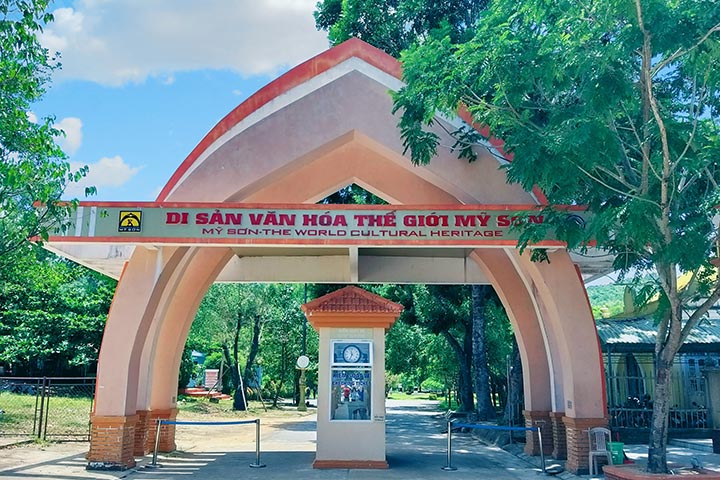
Ticket Price to My Son Sanctuary
| Foreigners: | 150,000VND/person |
| Vietnamese: | 100,000VND/person |
The Plan of Mỹ Sơn site
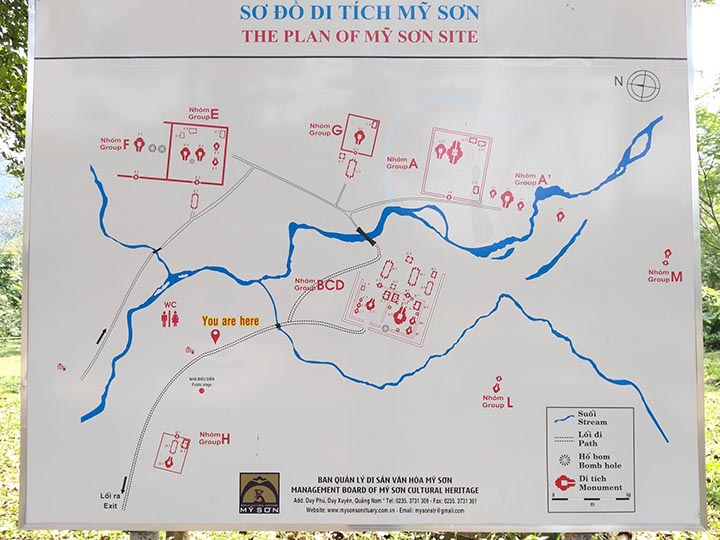
In My Son Sanctuary, you need around 2 hours trekking, walking inside the valley. It is very hot and humid there so You should prepare comfortable clothes, suitable for the trip, do not forget to bring hats, umbrellas. From September to December, in Vietnam is the rainy season, you should check the weather forecast before departure to bring rain coats.
Mysterious Apsara Dances
Inspired by the stone statues of Apsara (female dancer Yang Naitri) in the bas-reliefs or sandstone statues, incarnating from stone into flexible dances, showing the beauty of the perfect curve of women, Apsara dances are performed at public art shows and even professional stages. In all cultural events in Quang Nam province in general or in My Son Sanctuary in particular, the whole Kate festival you will admire the fanciful dance – this enchanting “soul of rock” dance makes You seem to be lost in the ancient Cham culture with the pictures of girls with arms, round breasts, seductive curves in bright, sparkling clothes, in Paranung drum and Sarainai trumpet.
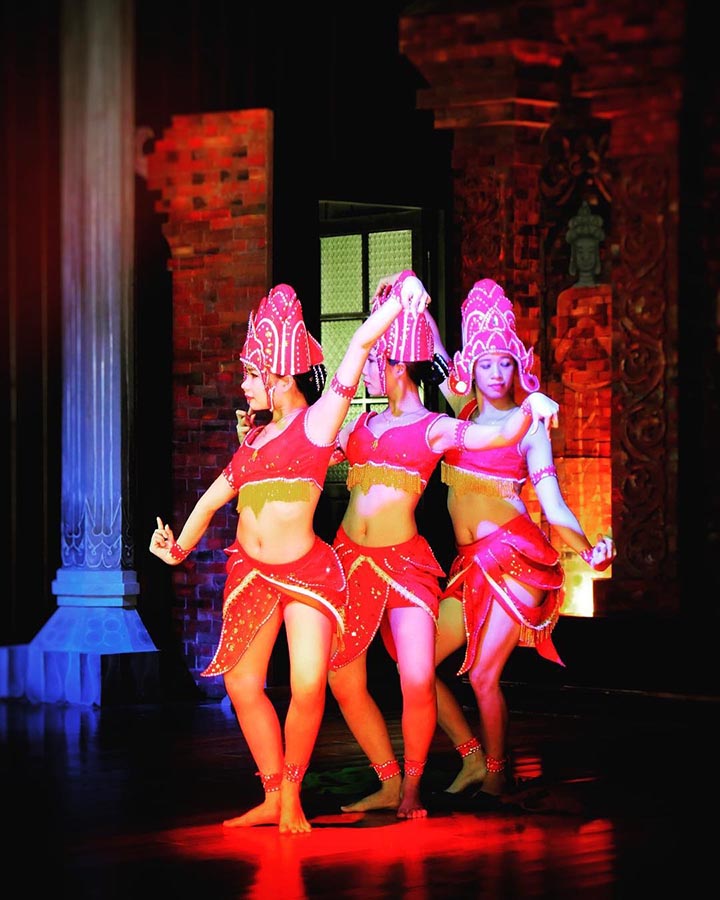
My Son Sanctuary not only preserves the ancient traces of an ancient civilization but also contains extremely unique historical, cultural, architectural and artistic values. If you come to Hoi An or Danang and ignore My Son Holyland – UNESCO World Cultural Heritage, it is really a great omission for your journey.

